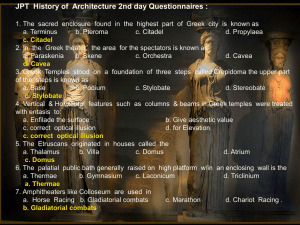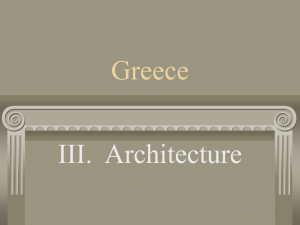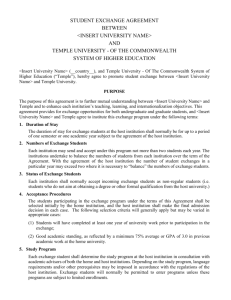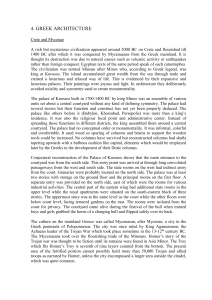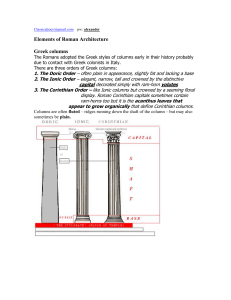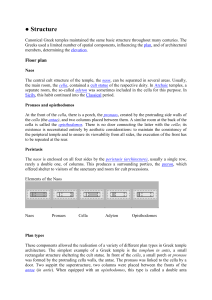Arch 1 Chaper 6
advertisement
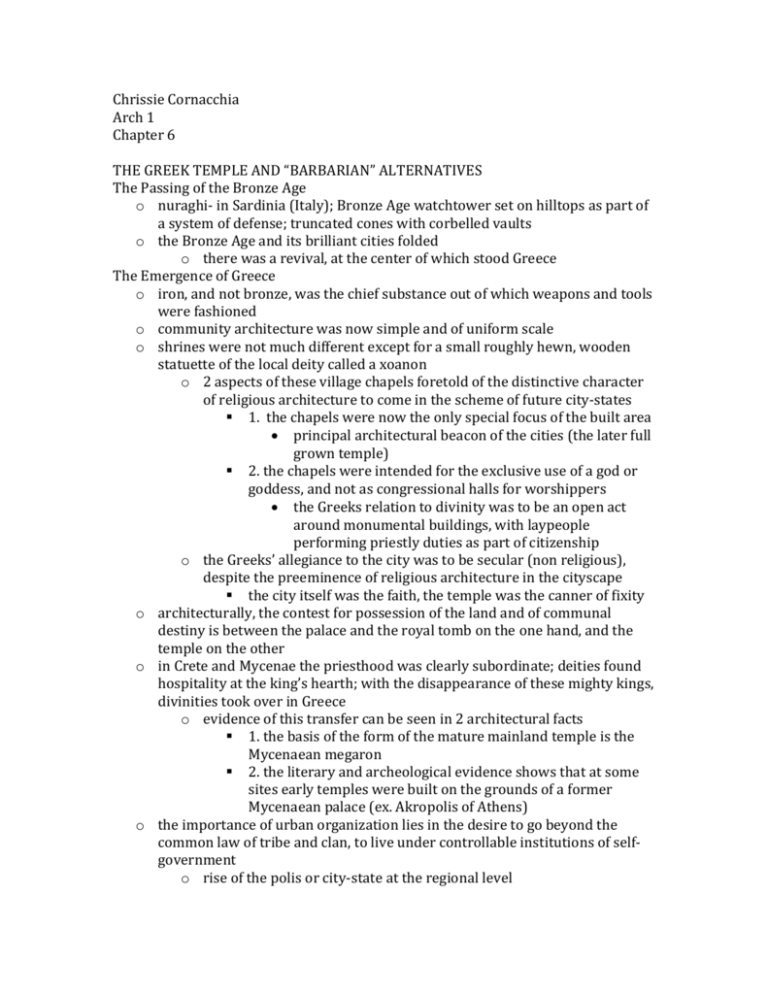
Chrissie Cornacchia Arch 1 Chapter 6 THE GREEK TEMPLE AND “BARBARIAN” ALTERNATIVES The Passing of the Bronze Age o nuraghi- in Sardinia (Italy); Bronze Age watchtower set on hilltops as part of a system of defense; truncated cones with corbelled vaults o the Bronze Age and its brilliant cities folded o there was a revival, at the center of which stood Greece The Emergence of Greece o iron, and not bronze, was the chief substance out of which weapons and tools were fashioned o community architecture was now simple and of uniform scale o shrines were not much different except for a small roughly hewn, wooden statuette of the local deity called a xoanon o 2 aspects of these village chapels foretold of the distinctive character of religious architecture to come in the scheme of future city-states 1. the chapels were now the only special focus of the built area principal architectural beacon of the cities (the later full grown temple) 2. the chapels were intended for the exclusive use of a god or goddess, and not as congressional halls for worshippers the Greeks relation to divinity was to be an open act around monumental buildings, with laypeople performing priestly duties as part of citizenship o the Greeks’ allegiance to the city was to be secular (non religious), despite the preeminence of religious architecture in the cityscape the city itself was the faith, the temple was the canner of fixity o architecturally, the contest for possession of the land and of communal destiny is between the palace and the royal tomb on the one hand, and the temple on the other o in Crete and Mycenae the priesthood was clearly subordinate; deities found hospitality at the king’s hearth; with the disappearance of these mighty kings, divinities took over in Greece o evidence of this transfer can be seen in 2 architectural facts 1. the basis of the form of the mature mainland temple is the Mycenaean megaron 2. the literary and archeological evidence shows that at some sites early temples were built on the grounds of a former Mycenaean palace (ex. Akropolis of Athens) o the importance of urban organization lies in the desire to go beyond the common law of tribe and clan, to live under controllable institutions of selfgovernment o rise of the polis or city-state at the regional level o Greek city was founded on 2 concepts 1. the right of private property 2. individual freedom o the hearth became the city, and every Greek became above all a citizen The Greek Temple o temples 1. served as the symbol of a broad union of Greeks 2. served as the symbol of each city’s special involvement with one of the immortals 3. distinguished Greek from “barbarian” and 1 Greek city from the others o the message of the temple to its audience was that the same architecture and religious iconography could be used to make very individual statements o the message to the alien world was that of a free people, subject to neither king nor priest o we should distinguish 3 overlapping stages in the evolution of the temple: o 1. apsidal chapels prevalent in the obscure period following the Dorian occupation of mainland Greece o 2. apsidal form was everywhere abandoned in favor of strict rectangularity; the cult room (cella) created a tunnel view, peristyle, formal portico Greek builder at Samos chose to enshrine the peristyle hall with an architectural screen; changed the concept of the temple to an external thing, a form that mattered as a midspace object and had visual validity from all sides o 3. the shift to permanent materials was completed with the invention of terra-cotta tiles as a new roofing material o kouros- public statues of young men and women singled out for athletic prowess or exceptional virtue began to people the periphery of the temples (full-size images existed as civic monuments) o the architect practiced with the aid of documents that were considered to be divinely inspired and were kept in the archives of temples o The Doric Order- Greek architecture is conservative; it invented little and invention was slow o Greek thinking takes on an idea, nourishes and perfects it trough a series of conscious changes; the process is ideal, that is, based on “the perfection of kind” o Doric Temple- a supremely artificial construct o the contrast of the natural and the devised is at the heart of Greek religious architecture o where the temple came to stand was not a matter of arbitrary choice; the choice had been made by what had once transpired on the land the first step in the commemoration of the site was the terrace the freestanding rectangular shape of this terrace clearly announced that the finished temple would not attempt to blend in with its surroundings 3 continuous steps lifted the temple to make it equally approachable from all sides the length and width of the top platform determines how many columns the temple would have as well as their spacing the number of columns for the standard peristyle would be set at 6 and 14, counting corner columns twice entasis- slight bulging of the shaft profile of columns fluting of the shaft helped to convey the feeling of compression capital consists of 2 parts: a flaring echinus that broadens the circle of the shaft top and the square unit of the abacus on which the architrave block rest o the principle of empathy is central to the understanding of Greek architecture (metaphor of Greek column as to do with human body) o the architrave completes the vertical definition of the peristyle band of stone separating colonnade proper from the crowning elements of the temple (frieze, gables, pediments) o marble columns were sometimes waxed to gleam under the light the frieze above was painted gaily; blue for the triglyphs and red for the background of the metopes o architectural symbol required that triglyphs occupy the corner of the frieze; the last triglyphs on each side of the temple had to be displaced in relation to the corresponding capitals below= wider space between corner triglyphs and their immediate neighbors; 2 solutions: 1. progressive stretching of frieze elements next to corner 2. reducing the span of the columns close to the corner, a procedure known as angle contraction o the groundline of the terrace curved upward toward the middle of each side, the columns tapered and had slightly convex profiles, the 4 corner columns inclined inward and back and were also made thicker o the temple was the meeting ground of the human and the divine o the buildings and statues were seen according to the way the worshipper moved through the site along time-worn paths the temenos was caught in a process of continuous becoming; yet it was also complete at every stage of its growth o The Temple in the Westo the strange land in the West posed 2 problems: 1. it was not marked by a legendary age of pre-Hellenic ancestors 2. the look and feel of the land was alien o Temple C at Selinus- built of local stone; general plan is very elongated with 17 columns along the flanks; cella is consequently long and narrow axial approach in the longitudinal sense (certain features favor east facade) o Etruscan temple- was raised on a high podium that jutted beyond a rectangular precinct manifested in the Etruscan fondness for the round arch and the circular plan o The Iconic Order o crystallized on the Aegean islands and in coastal Asia Minor o the Iconic is a more delicate and more ornate convention o Vitruvius was to consider it the feminine order, in contrast to the Doric order with “manly beauty, naked and unadorned” o iconic ornamental details favor curvilinear and freely recall leaf and plant forms o taller and thinner by comparison; rests on an elegantly molded base o Artemision at Ephesos (560-550 BC) King Croesus’ interests affected the final form of the temple low marshy sites are as common for Iconic temples as is precipitous high ground for Doric peristyle consisted of a double row of columns; cella may have been open to the sky in the middle o Temple against Palace the palace was viewed as an offering (at Persepolis) for a time at least, the temple held its own against the palace





